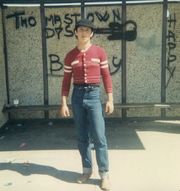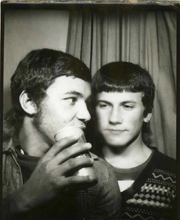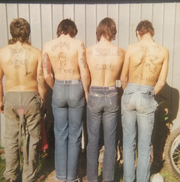mNo edit summary |
(Adding categories) |
||
| (2 intermediate revisions by 2 users not shown) | |||
| Line 1: | Line 1: | ||
| − | '''Sharpies''', (or '''Sharps''' |
+ | '''Sharpies''', (or '''Sharps,''' not to be confused with '''SHARP''' ''(Skinheads Against Racial Prejudice))'' were members of suburban youth gangs in Australia, most significantly from the 1960s and 1970s. They were particularly prominent in Melbourne, but were also found in Sydney and Perth to lesser extents. Like skinheads, sharpies were frustrated and rebellious youth, often from working-class homes, and gang violence was part of the lifestyle. Sharpie gangs were frequently named after the suburb or street the gang members came from. Gangs were very territorial and fought between themselves, or against local surfers. However, it is unclear exactly how much fighting actually happened. Despite its distinctive aesthetic, the Sharpie style was short-lived, and therefore poorly documented. |
| + | <br /> |
||
| − | Common clothing items included Lee or Levi jeans, cardigans, jumpers, and T-shirts—often individually designed by group members. |
||
| + | |||
| + | == Fashion == |
||
| + | |||
| + | === Clothing === |
||
| + | [[File:Sharpies-are-still-australias-coolest-gang-body-image-1438312139.png|thumb|A typical Sharpie; note that the undersized sleeves don't reach the wrist]] |
||
| + | Sharpie fashion has its roots in '60s European trends, notably English [[Mod|Mods]] and the [[preppy]] look, that were brought with an influx of post-war migrants to Australia. The look was initially sleek and "sharp," hence the name, though by the '70s the fashionable flare-legged pant had been adopted. The classic look (for any gender) was a mullet, high-waisted flared pants or jeans, and a cardigan. |
||
| + | |||
| + | The most important item of Sharpie clothing was the ultra-tight cardigan called a "Conny." The name comes from "Conte," the surname of the tailors in Melbourne who originally made the cardigans. Connys were often striped, and it was popular (though expensive) to have one's own Conny custom-made with colors and designs of one's choice. Connys were frequently worn several sizes too small, to display one's fit figure. |
||
| + | |||
| + | Sharpie girls, called "brushes," wore Connys but also tended to have more variety in their wardrobe, sometimes wearing [https://en.wikipedia.org/wiki/Twinset twinsets], pleated skirts or miniskirts, or pinafores. |
||
| + | |||
| + | Heavy platform shoes were the standard footwear, as tall as possible. Subtle variations in design provided signals as to where a Sharpie came from, depending on which shop they bought the shoes from. |
||
| + | <br /> |
||
| + | [[File:Sharpies-are-still-australias-best-gang-110-1438311828.png|thumb|The popular Sharpie haircut, with visible ear piercings]] |
||
| + | |||
| + | === Hairstyle === |
||
| + | The popular hairstyle was a sort of mullet: short all over and long, though not necessarily full, in the back. This style actually anticipated the European and American mullet trend by several years. Red dye was popular, as was bleaching one's hair. Girls tended to wear their hair a bit longer. |
||
| + | <br /> |
||
| + | [[File:Sharpies-are-still-australias-coolest-gang-body-image-1438312335.png|thumb|Some Sharpies got the names of their core gang members tattooed on them]] |
||
| + | |||
| + | === Tattoos and jewelry === |
||
| + | Though illegal to tattoo anyone under 18, multiple tattoos were part of the standard Sharpie uniform. Along with professional-looking tattoos were shoddy, homemade ones, done with pen ink, wire, and a small motor. |
||
| + | |||
| + | Thanks to the short Sharpie hairstyle exposing the ears, attention was drawn to a new fashion trend: the male pierced ear. The notion of pierced ears, long hair, and hippy street fashion as "feminine" was something that Sharpies revolted against with strongly macho behavior. |
||
[[Category:Fashion]] |
[[Category:Fashion]] |
||
[[Category:Australian]] |
[[Category:Australian]] |
||
[[Category:Needs work]] |
[[Category:Needs work]] |
||
| + | [[Category:Masculine]] |
||
Revision as of 01:12, 15 March 2021
Sharpies, (or Sharps, not to be confused with SHARP (Skinheads Against Racial Prejudice)) were members of suburban youth gangs in Australia, most significantly from the 1960s and 1970s. They were particularly prominent in Melbourne, but were also found in Sydney and Perth to lesser extents. Like skinheads, sharpies were frustrated and rebellious youth, often from working-class homes, and gang violence was part of the lifestyle. Sharpie gangs were frequently named after the suburb or street the gang members came from. Gangs were very territorial and fought between themselves, or against local surfers. However, it is unclear exactly how much fighting actually happened. Despite its distinctive aesthetic, the Sharpie style was short-lived, and therefore poorly documented.
Fashion
Clothing

A typical Sharpie; note that the undersized sleeves don't reach the wrist
Sharpie fashion has its roots in '60s European trends, notably English Mods and the preppy look, that were brought with an influx of post-war migrants to Australia. The look was initially sleek and "sharp," hence the name, though by the '70s the fashionable flare-legged pant had been adopted. The classic look (for any gender) was a mullet, high-waisted flared pants or jeans, and a cardigan.
The most important item of Sharpie clothing was the ultra-tight cardigan called a "Conny." The name comes from "Conte," the surname of the tailors in Melbourne who originally made the cardigans. Connys were often striped, and it was popular (though expensive) to have one's own Conny custom-made with colors and designs of one's choice. Connys were frequently worn several sizes too small, to display one's fit figure.
Sharpie girls, called "brushes," wore Connys but also tended to have more variety in their wardrobe, sometimes wearing twinsets, pleated skirts or miniskirts, or pinafores.
Heavy platform shoes were the standard footwear, as tall as possible. Subtle variations in design provided signals as to where a Sharpie came from, depending on which shop they bought the shoes from.

The popular Sharpie haircut, with visible ear piercings
Hairstyle
The popular hairstyle was a sort of mullet: short all over and long, though not necessarily full, in the back. This style actually anticipated the European and American mullet trend by several years. Red dye was popular, as was bleaching one's hair. Girls tended to wear their hair a bit longer.

Some Sharpies got the names of their core gang members tattooed on them
Tattoos and jewelry
Though illegal to tattoo anyone under 18, multiple tattoos were part of the standard Sharpie uniform. Along with professional-looking tattoos were shoddy, homemade ones, done with pen ink, wire, and a small motor.
Thanks to the short Sharpie hairstyle exposing the ears, attention was drawn to a new fashion trend: the male pierced ear. The notion of pierced ears, long hair, and hippy street fashion as "feminine" was something that Sharpies revolted against with strongly macho behavior.
